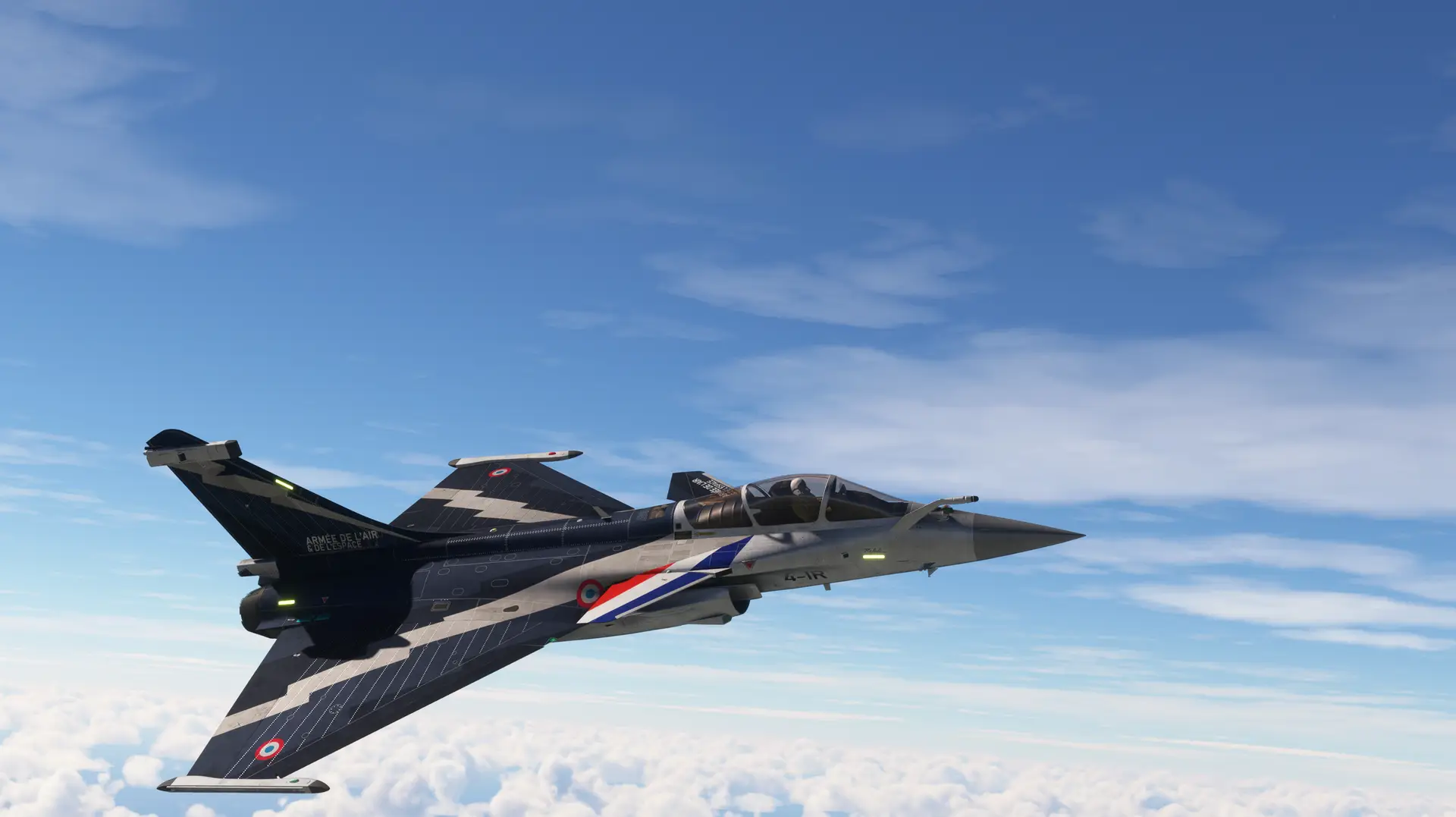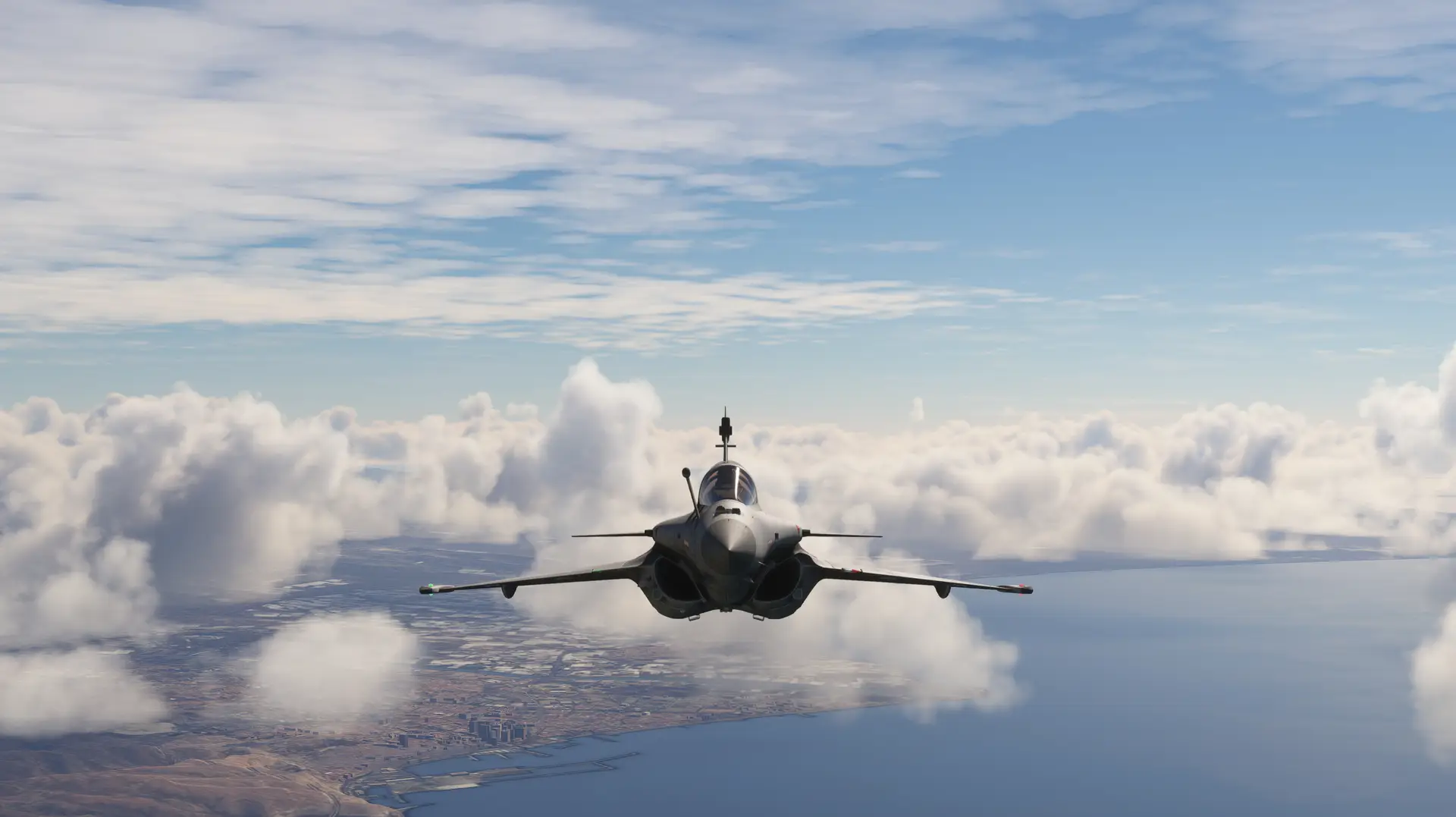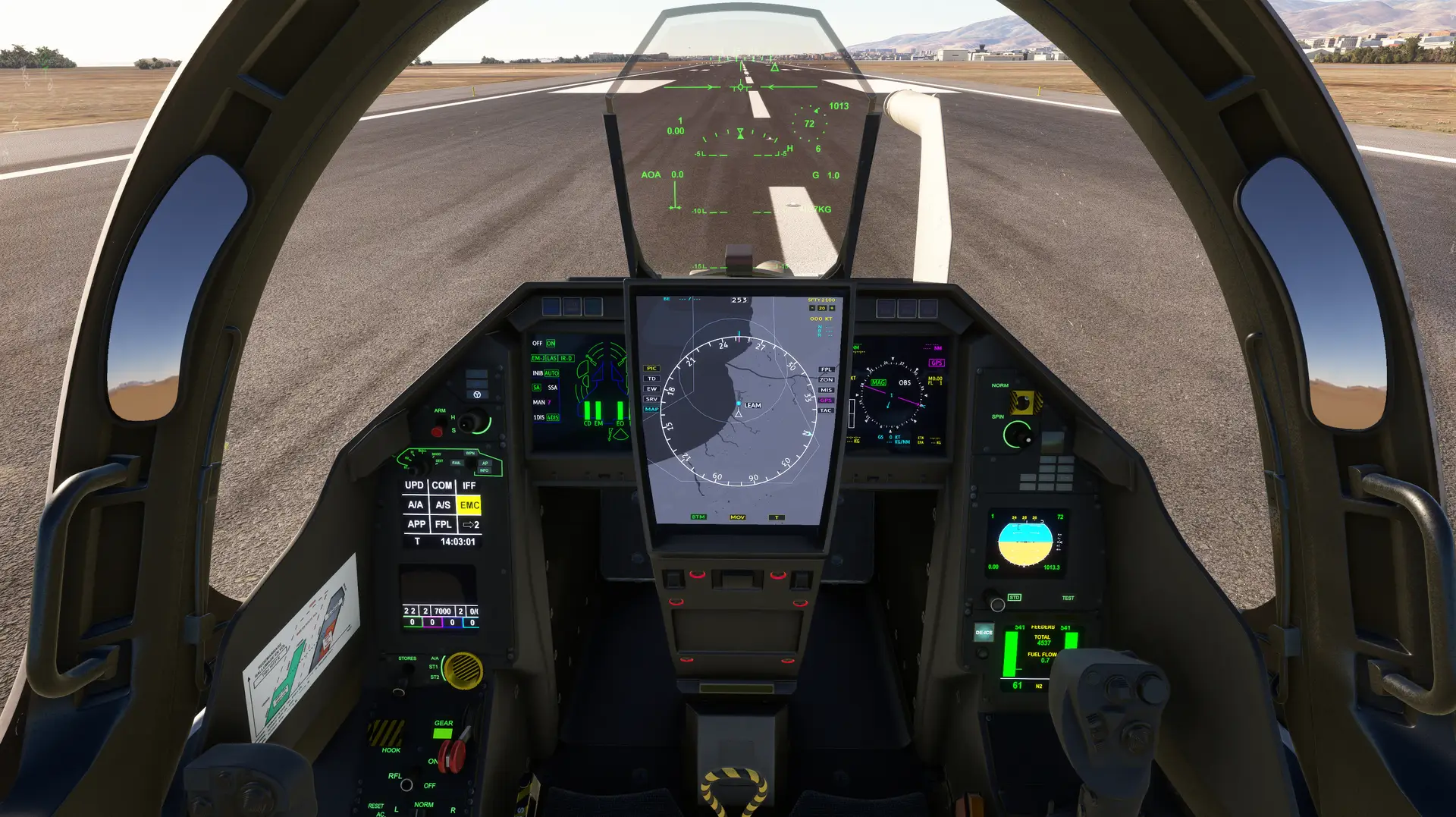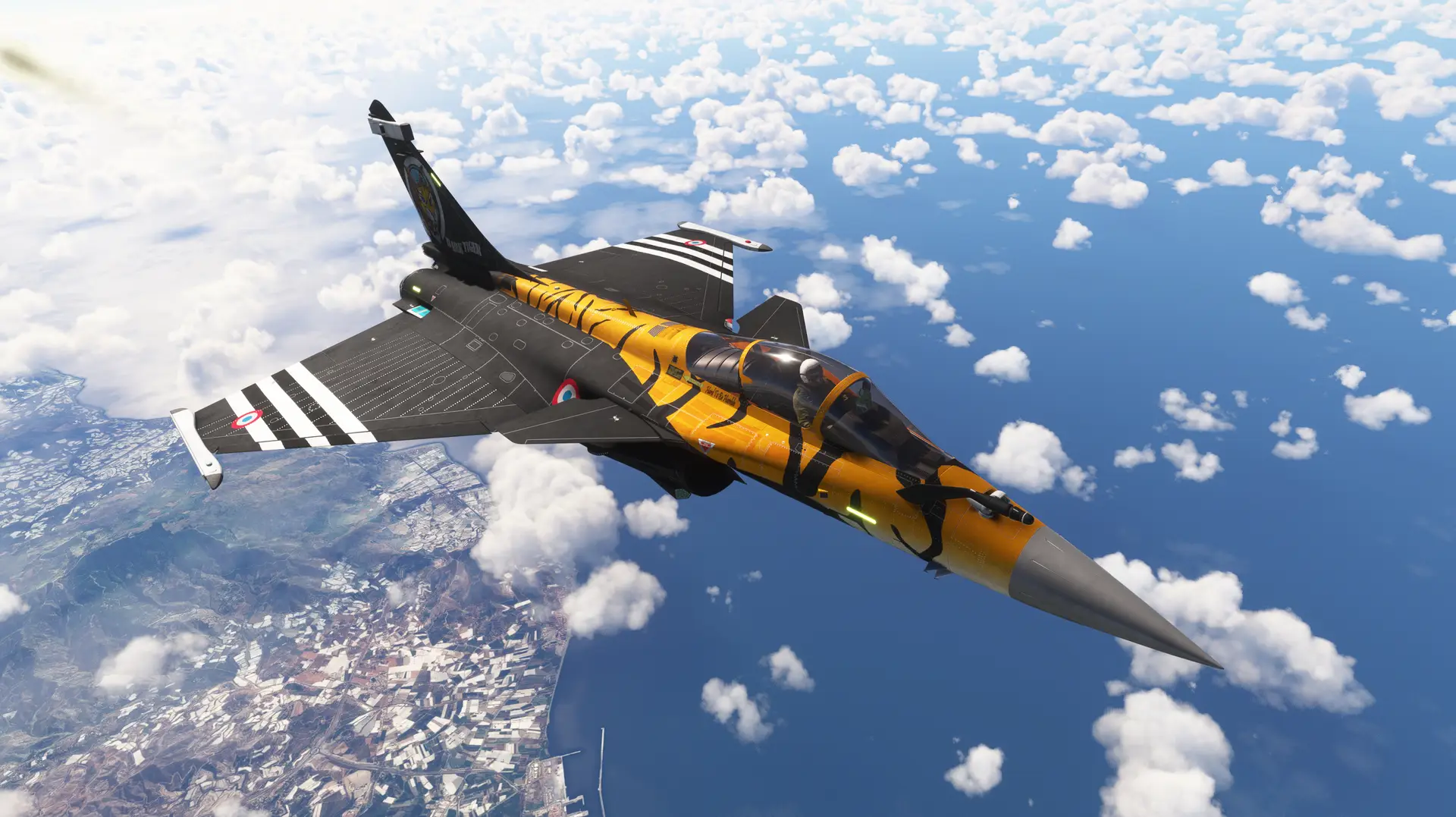VERSION 1.0.6 RELEASED FEBRUARY 13, 2024
CJS R-Fal v1.0.6
Changelog:
Any reference that could violate any copyright has been removed.
- Review of the flight model.
- Fixed a bug that caused the plane to reach mach speeds higher than the high altitude flight envelope.
- Replaced the modeling of all cockpit switches.
- Enabled Hot-safe switch to silence some audible alarms (especially low altitude flight).
- Fixed 65 Ans Livery.
CJS R-Fal v1.0.5
- R-Fal-specific sound pack added.
- External model:
o Revised animations on foreplanes, slats, elevons, nozzles and
landing gear.
o Fixed the positioning of Pitot sensors.
o Revision of fuselage textures and PBR maps.
o XBOX. Texture size reduction has been made to optimize memory
load on GPUs. However, if performance problems or CTD's are
detected, it is recommended:
1.- Review third-party addons, such as airports, general texture
improvement packs, etc., that could be pushing Xbox to the
memory usage limit.
2.- Run the Reset and Keep My Games & Apps feature from the Xbox
System Menu.
- Internal model:
o Fixed the geometry of HUD mounts.
o Fixed the positioning of some switches.
- Manual: The first chapters of the flight manual have been added to the DOCS folder. This manual will be expanded/corrected with each update.
Although XBOX users cannot access this directory, they can request it via email or through the discord channel.
- Weapons: As all users know, to comply with PEGI rules, weapons are disabled by default. In the case of PC users, the weapons can be activated through a downloadable patch.
Documentation for downloading/installing this patch has been added to DOCS folder. Note: it is very important that in each update the weapons patch from the previous version be removed since it will not work with the new version.
The new compatible version will need to be installed instead.
- Liveries: Added 65 Ans and White Tiger liveries for R-Fal M.
VERSION 1.1.0 RELEASED MARCH 26, 2024
Changelog 1.1.0:
- FlightModel: Increased overall drag.
- HUD: Corrected chevrons behavior, added
longitudinal acceleration indicator as
per the real HUD while on ground, added
Weight on Wheels symbol, corrected Horizon
line taking into account earth radius and
sphericity.
- HMD: Added HMD (dimmable through right central knob).
- FAIL page: An initial version of the FAIL page has been
implemented (it is provisional and subject to changes at
the UI level in future updates).
- R-Fal M landing gear: Although certain elements of the
landing gear are going to be replaced at a 3D level in
future updates, its current dimensions have been corrected
in order to differentiate the nose up characteristic of
this version compared to R-Fal C when it is on ground.
- Wheel animations: The wheel rotation animations of all models
have been corrected to make their movement more linear.
- XBOX X/S: The flags of some textures have been removed so
that their resolution is managed dynamically depending on
the available memory, so that these platforms manage the
memory load at all times. This should help avoid black
avionics depending on the scenario and your GPU load. However,
it is always recommended to review third-party add-ons that may
be pushing the maximum available memory capacity to the limit.
- PC: Please note that with each new update the optional patch
that activates the display of weapons on PC must be replaced.
The information is always included in the Documents folder.
VERSION 1.1.1 RELEASED MAY 1, 2024
Changelog 1.1.1:
- Converted the majority of textures to BC1 format, maintaining the same quality but reducing GPU load by half. This upgrade, previously applied only to the Xbox versions, is now implemented on PC as well.
- Corrected cockpit lighting.
- Replaced cockpit base textures with ones that more closely resemble the real aircraft.
- Updated Afterburner effects to enhance realism.
- Added distinctive sawtooth edges to the foreplanes, wings, and flaperons.
- HUD: The horizon line projection formula on the HUD has been refined to better reflect the Earth’s curvature and accommodate different altitudes. Additionally, precision is adjusted based on the aircraft’s bank angle.
- HMD: Two methods for projecting the HMD via the HUD/HLD switch have been implemented. In HUD mode, the HMD will function as in real life, hiding when it collides with the HUD. In HLD mode, it will not hide, but it will be necessary to dim the HUD to 0 for it to be used instead.
VERSION 1.1.4 RELEASED JUNE 6, 2024
Changelog 1.1.4:
Cockpit:
- The interior tint of the canopy glass has been removed (the external tint remains).
Exterior:
The external fuselage textures have been reviewed, reducing the metallic effect of the PBR components and adjusting the plane's color tone. The wear and dirt effects on the paint have been refined for both variants.
Thumbnails for the different liveries have been updated to make them easier to distinguish in the menu.
VERSION 1.1.7 RELEASED DECEMBER 2, 2024
Changelog 1.1.7:
Cockpit:
Redesigned the cockpit's front panels, side panels, and canopy to better resemble the real-life model.
Optimized texture sizes to reduce GPU load, removing textures from non-visible areas.
Reworked some textures to add wear and tear to cockpit elements that appeared overly "clean."
Optimized geometry to improve framerate performance.
Adjusted the general cockpit camera zoom from 0.45 to 0.35 and redesigned the instrument cameras.
Exterior:
Reduced the resolution of certain textures to optimize GPU load without noticeable quality loss.
Recreated PBR textures to give the fuselage a more realistic wear and tear appearance.
Corrected landing gear light illumination to avoid glare while maintaining effective nighttime lighting.
Updated nozzle textures to add wear and tear details.
Additions:
Added the "SuperNouNou" (SNN) variant of the M model, which shares liveries with the M model. This variant includes a Refueling Pod, two 2000L tanks, and two 1250L tanks.
This variant is cosmetic only and does not perform refueling functions in either single-player or multiplayer modes. However, it should be compatible with Airshow Assistant if the owner enables it.
Compatibility with MSFS2024:
After extensive testing, it can be concluded that the R-Fal is 99% compatible with MSFS2024. However:
Since flight plans in MSFS2024 are managed through the simulator's EFB, it is recommended not to create flight plans or procedures from the FPL and FM pages. Instead, use the FlightPlanner tool in the EFB, and once completed, select the first option "File Plan with ATC" so it can be read and managed by the MFDs. After this, you should be able to view and manage the flight plan from FPL, including activating legs, loading approach frequencies, etc.
Until Asobo patches MSFS2024, pilots are not visible in any MSFS2020 aircraft used in MSFS2024 (this is intentional by Asobo due to pilot positioning issues during the Alpha version).
Afterburner effects currently experience a visual illumination delay upon disengagement (this is also a core SIM issue that Asobo needs to resolve).
VERSION 1.1.8 RELEASED JANUARY 19, 2025
Changelog 1.1.8:
Hotfix for SNN model:
A problem preventing the APU from being activated in Cold & Dark mode, which is necessary to start the aircraft's engines, has been fixed.
Additionally, an issue with the 3D vision display on the central screen has been fixed too.
General:
After identifying that the vertical speed during altitude changes using ALT SEL at low airspeeds was too low, the formula has been adjusted to increase it: ALT SEL calculates vertical speed based on an interpolation between the minimum flight speed and the maximum allowed speed to prevent stalling, ranging from a minimum of 500 fpm (near the stall region) to 12,000 fpm (around 800 IAS). At IAS values between 250 and 350, the vertical speed should now range between 3,500 and 4,500 fpm. This vertical speed gradually zeroes out as the current altitude approaches the target altitude.
The HUD projection limits have been increased after detecting that the FPV would disappear at the lower boundary during high angles of attack (necessary during approach and landing phases).
An automatic scroll function has been added to the FPL page to follow the current waypoint without requiring manual scrolling.
Cosmetic weapons visualization has been enabled for all variants without requiring additional patches. (Note: From now on, any PC weapon activation mods must be removed from the community directory, as they are no longer necessary and could cause conflicts in both MSFS2020 and MSFS2024.)
VERSION 1.1.9 RELEASED OCTOBER 3, 2025
Changelog 1.1.9:
Interior:
The stock FA-18 pilot model has been replaced with a custom one to fix glitches caused by the previous model.
Reviewed/updated several cockpit textures.
Adjusted the geometry of the front dashboard buttons.
Exterior:
- The R-Fal M landing gear geometry has been redesigned from scratch. Corrected its longitudinal position and vertical height. Deflection and compression animations have been implemented to match the real aircraft. Landing gear bay dimensions have been corrected to the real-world sizes.
Minor tweaks to several liveries.
Screens:
- FPL page: Added behavior so that after a period of inactivity (when the flight plan isn’t being edited), the cursor automatically snaps to the active waypoint. Additionally, if a flight plan is created without an origin and only a destination, it now behaves as a Direct-To.
Flight model:
- Reviewed/tuned the FBW PID controller and the autopilot.
MSFS 2024 fixes:
Fixed a compatibility issue that prevented creating SID, STAR, and approach procedures within a flight plan from the FM page in MSFS 2024.
Since SU3, Asobo's EFB has a bug that prevents sending flight plans to V1 avionics; therefore, it’s recommended to create and manage flight plans from the aircraft’s internal avionics.




